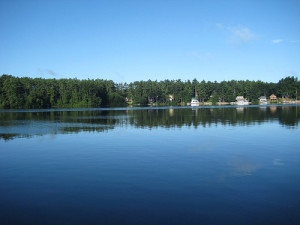Maine Lakefront Primer: The ABCs of Watershed Terminology
On the Maine Lakefront Property Owner’s Bookshelf: Our Kezar
October 2, 2014Out and About for the Bangor Lakes Region of Maine Oct. 9-15
October 9, 2014Maine Lakefront Primer: The ABCs of Watershed Terminology
Mousam Lake, Shapleigh, Maine: Doesn’t This Make You Want to Jump In?
Because we use a variety of terms when we write or talk about lakefront property and the surrounding watershed, we thought you’d appreciate having lakespeak defined.
Algal bloom–rapid growth of algae in water due to excessive amounts of nutrients, such as phosphorus.
Best Management Practices (BMPs)–methods or practices implemented to prevent and/or reduce water pollution.
Chlorophyll–green pigment found in photosynthetic organisms
Dissolved Oxygen–the amount of oxygen present in the water column, which is important for aquatic organisms. The lower the oxygen concentrations, the greater the stress on these organisms.
Erosion–the wearing away of rock and soil due to wind, weathering, wave action, ice or other forces. Land-use activities may increase the rate of erosion.
Groundwater–water occurring beneath the earth’s surface that supplies wells and springs.
Heavy metals–metals that do not degrade over time, thus becoming an environmental concern. Examples of heavy metals include cadmium, mercury, nickel and lead.
Impervious surface–a surface that does not allow water to penetrate, such as asphalt, concrete and rooftops.
Land use–the way land is used or developed, including buildings/structures and activities. Particular land uses are often associated with different types of pollution, e.g. erosion and sedimentation from construction activities.
Monitoring–repeated observation, measurement or sampling at a site, on a scheduled basis.
Non-Point Source (NPS) Pollution–pollution that enters water from a variety of sources as a result of runoff from rainfall or snowmelt. As the water moves over and through the ground, it transports natural and human-made pollutants into surface waters and underground sources of drinking water.
Nutrients–substances, such as nitrogen and phosphorous that are required by plants and animals for growth. Excessive nutrient additions to surface waters may result in algal/plant growth and, subsequently, the accumulation and decay of increased organic matter.
Point Source Pollution–pollution that can be traced to a single point, or output, such as a pipe.
Runoff–water flowing across the land that does not infiltrate the soil, but drains into surface or ground waters. Sometimes runoff occurs when rainfall exceeds the infiltration capacity of the land.
Sedimentation–the deposition of particles of soil, sand, silt, clay or organic matter onto the bottom of any surface water.
TMDL (total maximum daily load)–calculation of the maximum amount of a pollutant that a water body can receive and still meet water quality standards and allocation of that amount to the pollutant’s sources.
Turbidity–a measurement that indicates the amount of suspended solids in the water column.
Vegetated buffer–a vegetated area designed to filter pollutants before they reach surface waters and provide a barrier against runoff.
Watershed–the ecosystem consisting of three major components, stream channel, floodplain, and upland areas, that function together and drain to water bodies, including lakes, rivers, wetlands, streams and the surrounding landscape.
Wetlands–areas such as bogs, swamps and marshes that are frequently inundated or saturated with water for periods of time long enough to support vegetation suited for survival in saturated soils.
To learn more about lakefront properties for sale on Mousam Lake, click on the green box above.
To learn more about lakes in Shapleigh, Maine, click on the blog links below.
Mousam Lake in Southern Maine – Perfect for Boaters, Anglers and Vacationers
Goose Pond, Shapleigh, Maine: Experience Halcyon Days on Serene Water

